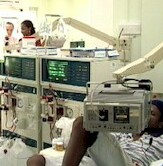
TUESDAY, Sept. 28 (HealthDay News) — Patients with end-stage kidney disease who have dialysis at home fare just as well as their counterparts who do hemodialysis, which is traditionally performed in a hospital or dialysis center, new research shows.
“This is the first demonstration with a follow-up for up to five years,” said Dr. Rajnish Mehrotra, lead author of the study that is published online Sept. 27 in the Archives of Internal Medicine. “Not only was there no difference, the improvements in survival have been greater for patients who do dialysis at home.”
Yet patients seem loathe to pick the at-home option, known as peritoneal dialysis, even if they’re aware of its existence, finds another study in the same issue of the journal.
And, as an accompanying editorial points out, the proportion of Americans using peritoneal dialysis plummeted from 14.4 percent in 1995 to about 7 percent in 2007.
Both forms of dialysis essentially act as replacement kidneys, filtering and cleaning the blood of toxins, explained Dr. Martin Zand, medical director of the kidney and pancreas transplant programs at the University of Rochester Medical Center in Rochester, N.Y.
For peritoneal dialysis, fluid is passed into the abdomen via a catheter. The body’s own blood vessels then act as the filter. But patients have to be able to lift 2 liters of fluid at a time and hook it up to a pole, and to do this several times a day, Zand explained.
But hemodialysis (which can be done at home, though it takes up huge volumes of water) is generally necessary only a few times a week.
The first study analyzed national data on 620,020 patients who began hemodialysis and 64,406 patients who began peritoneal dialysis in three time periods: 1996-1998, 1999-2001 and 2002-2004.
Although patients receiving peritoneal dialysis in the earlier periods had a slightly higher risk of death than those on hemodialysis, that difference had disappeared by the later time period, with those on hemodialysis living an average of 38.4 months and those on peritoneal dialysis living an average of 36.6 months.
The second study also looked at a national database of patients, this time to discover if patients who received information on peritoneal dialysis were more likely to actually choose this method.
Nancy Kutner and colleagues found that although almost two-thirds (61 percent) of patients said they had discussed peritoneal dialysis with their health-care provider, only about 11 percent actually chose this option.
Rates of people preferring hemodialysis over peritoneal dialysis differed somewhat depending on which dialysis company owned the center they were using.
The researchers, from Emory University in Atlanta, also found that patients on hemodialysis were more likely to be black and living alone, while those on peritoneal dialysis were more likely to be high school graduates and to be working.
Any number of reasons could explain the disparity.
Peritoneal dialysis is a better option for people living in remote locations or who travel a lot. “There’s more freedom,” Zand said. But being asked to take charge of your own dialysis could feel like being asked to pilot a plane.
“The prospect of going on dialysis is scary enough in itself. Nobody ever says ‘When can I start?'” Zand said. “It’s often a very daunting prospect for people.”
But in previous research, Mehrotra found that up to one-half of patients who are given the choice will go with peritoneal dialysis, indicating that the quality of patient education matters.
“We need to do a better job of educating people of the advantages of peritoneal,” said Zand, who also pointed out that many nephrologists are pushing for a move to this modality. “There’s a wide variation in the quality of the information the patients are given and also the enthusiasm of the person actually giving that information.”
The fact that Medicare just started reimbursing physicians for patient education may help tip the balance, added Mehrotra, who is an associate chief of the division of nephrology at Harbor-UCLA Medical Center. “Now physicians can get reimbursed for patient education.”
Mehrotra’s study was funded by Baxter Health Care and the U.S. National Institutes of Health (NIH). The study by Kutner and colleagues was funded solely by the NIH.
More information
The U.S. National Library of Medicine has more information on the two types of dialysis.

